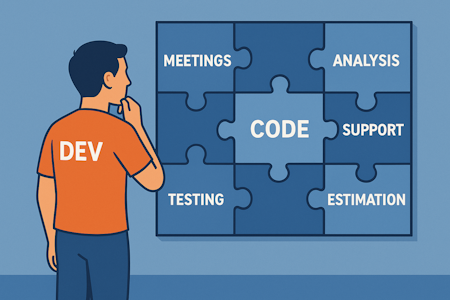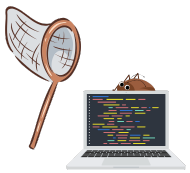Na blogu mojej strony Kurs Java opublikowałem czwarty artykuł z serii „Tworzenie gry Mazer”, w którym opowiadam o procesie tworzenia mojej gry Mazer na telefony i komputery stacjonarne. Zapraszam do czytania!
Archiwum autora: Przemysław Kruglej
Tworzenie gry Mazer – Rozdział 3: Development Mazera
Na blogu mojej strony Kurs Java opublikowałem trzeci artykuł z serii „Tworzenie gry Mazer”, w którym opowiadam o procesie tworzenia mojej gry Mazer na telefony i komputery stacjonarne. Zapraszam do czytania!
Tworzenie gry Mazer – Rozdział 2: Przedstawienie gry
Na blogu mojej strony Kurs Java opublikowałem trzeci artykuł z serii „Tworzenie gry Mazer”, w którym opowiadam o procesie tworzenia mojej gry Mazer na telefony i komputery stacjonarne. Zapraszam do czytania!
Rzemiosło tworzenia oprogramowania – Element #7 – Miej szerszy punkt widzenia
Tematem Elementu z mojego dokumentu „Craftsmanship of Software Development” tydzień temu było uznanie testowania za część naszej pracy (Element #6 – Uznaj testowanie za część swojej pracy). Tym razem opowiem Ci o patrzeniu na wytwarzanie oprogramowania z większej perspektywy.
Element #7 – Miej szerszy punkt widzenia¶

Wyobraź sobie: programista przychodzi do pracy, siada do swoich zadań i problemów do rozwiązania. Przez cały dzień pisze kod, a potem zadowolony wraca do domu. Dla wielu programistów, z … czytaj więcej…
Tworzenie gry Mazer – Rozdział 1: Ku przygodzie!
Na blogu mojej strony Kurs Java opublikowałem drugi artykuł z serii „Tworzenie gry Mazer”, w którym opowiadam o procesie tworzenia mojej gry Mazer na telefony i komputery stacjonarne. Zapraszam do czytania!
Rzemiosło tworzenia oprogramowania – Element #6 – Uznaj testowanie za część swojej pracy
Mój wpis sprzed tygodnia dotyczył pierwszego przetłumaczonego Elementu Wszechstronności (Element #5 – Szukaj odpowiedzi) z mojego dokumentu „Craftsmanship of Software Development”. Ten wpis dotyczy drugiego Elementu z tego zbioru.
Element #6 – Uznaj testowanie za część swojej pracy¶

Testowanie ma kluczowe znaczenie w naszej branży – często naszymi współpracownikami są dedykowani testerzy. Zajmują się testowaniem wtedy, gdy przekażemy im zadanie, które – naszym zdaniem – jest już gotowe.
Zdarza się jednak, że tester z naszego … czytaj więcej…
Tworzenie gry Mazer – prolog
Co mają kamienie szlachetne, wieża szachowa, plan mieszkania i sierżant do pisania gry? Co trzeba umieć i zrobić, aby stworzyć grę na telefony i komputery stacjonarne?
Na blogu mojej strony Kurs Java opublikowałem pierwszy artykuł z serii „Tworzenie gry Mazer”, w którym będę opowiadał o procesie tworzenia mojej gry Mazer na telefony i komputery stacjonarne. Zapraszam do czytania!
Rzemiosło tworzenia oprogramowania – Element #5 – Szukaj odpowiedzi
Wpis z zeszłego tygodnia dotyczył ostatniego przetłumaczonego Elementu Jakości (Element #4 – Bądź kimś, na kim można polegać) z mojego dokumentu „Craftsmanship of Software Development”. W tym wpisie przeczytasz o pierwszym Elemencie ze zbioru Wszechstronności.
Wszechstronność u programistów rozumiem jako zdolność do szybkiego dostosowywania się oraz rozwijania różnych umiejętności aby nadążać za zmianami, a także spoglądanie na problem bądź wyzwanie z szerszej perspektywy.
Element #5 – Szukaj odpowiedzi¶

Często, gdy zadasz koleżance/koledze z zespołu … czytaj więcej…
Wydałem moją pierwszą grę – Mazer

Od dzisiaj w Google Play Store (dla urządzeń z systemem Android) oraz w platformie Steam (komputery stacjonarne) dostępna jest moja gra Mazer.
Mazer to gra logiczna, w której musisz znaleźć drogę przez labirynt, przestrzegając zasad każdego napotkanego elementu. Dzięki 150 ręcznie wykonanym łamigłówkom o różnym stopniu trudności każdy poziom przetestuje Twoją logikę do granic możliwości!
Mazer jest darmowy i nie zawiera żadnych reklam. Jeżeli chcesz zainstalować go na swoim urządzeniu z systemem Android, to znajdziesz go tutaj: Mazer w … czytaj więcej…
Rzemiosło tworzenia oprogramowania – Element #4 – Bądź kimś, na kim można polegać
W tym tygodniu przedstawiam czwarty, a zarazem ostatni, przetłumaczony Element Jakości z mojego dokumentu „Craftsmanship of Software Development”. Poprzedni Element dotyczył dbania o drobne rzeczy. Dzisiaj opowiem Ci dlaczego warto być kimś, na kim można polegać.
Element #4 – Bądź kimś, na kim można polegać¶

Kiedy dołączasz do nowego projektu, często okazuje się, że są w nim osoby o których mówi się, że wiedzą wszystko na temat projektu i/lub są bardzo mocne technicznie. Można zapytać je … czytaj więcej…
